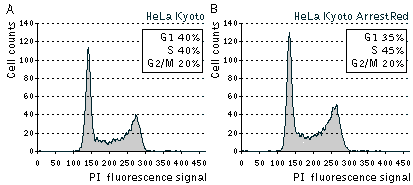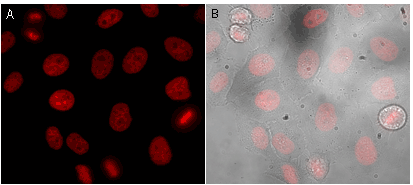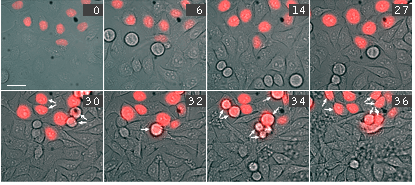
|
||||||||||
|
||||||||||

ArrestRed
SUPPORT |
|
 |
Time-lapse images of a representative single cell undergoing mitosis (numbers indicate time in minutes; red fluorescence and overlay of red fluorescence and transmitted light are shown) |
|---|
 | Cell cycle distribution in asynchronously growing populations of parental HeLa Kyoto and stably transfected HeLa Kyoto ArrestRed cells.Cells were analyzed by flow cytometry after staining with PI (propidium iodide) for the DNA content. |
|---|
Effects of light-activated ArrestRed on cell division in vitro:
Activation of ArrestRed in either transiently or stably transfected HeLa cells results in complete blockage of cell division for about 24 hours. During this time, cell nuclei have interphase morphology, and no cells undergo division. At the same time, most cells remain viable with no membrane blebbing, loss of attachments, cell shrinkage, or other signs of cell death. Over a second 24-h period, (24-48 h after activation of ArrestRed) approximately 90% of the ArrestRed-transfected cells undergo mitosis.
Activation of ArrestRed in mitotic cells results in nondisjunction of chromosomes and the cells are unable to complete division normally. In the end the cells return to interphase morphology with a decondensed tetraploid chromatin.
 | Time-lapse images of a representative HeLa cell expressing ArrestRed.Activation of ArrestRed was performed during metaphase (numbers indicate time in minutes; red fluorescence and overlay of red fluorescence and transmitted light are shown). |
|---|
Effects of light-activated ArrestRed in vivo:
The effects of light-induced activation of ArrestRed in the whole organism in vivo were demonstrated in transgenic Xenopus laevis embryos [Serebrovskaya et al., 2011].
In one set of experiments, the Xag2 promoter was used to specifically direct the ArrestRed expression in the cement gland, a provisory organ located at the rostral end of the embryonic head. Activation of ArrestRed (green light illumination with LED array, 525 nm, 45 mW/cm2, 1 hour) in transgenic embryos at the early neurula stage leads to clear retardation of the cement gland differentiation observed at the tadpole stage.
In another set of experiments, the tissue-specific promoter of the homebox gene Xanf1 was used to specifically induce the ArrestRed expression in the cells of the anterior neural fold between the middle gastrula and the late neurula stages of the development. Activation of ArrestRed (green light illumination with LED array, 525 nm, 45 mW/cm2, 1 hour) in transgenic embryos at the early-midneurula stages leads to various degrees of forebrain reduction accompanied by prominent optic stalk dysplasia, which in extreme cases resulted in a complete cyclopic phenotype observed at the tadpole stage.
References:
- Serebrovskaya EO, Gorodnicheva TV, Ermakova GV, Solovieva EA, Sharonov GV, Zagaynova EV, Chudakov DM, Lukyanov S, Zaraisky AG, Lukyanov KA. Light-induced blockage of cell division with a chromatin-targeted phototoxic fluorescent protein. Biochem J. 2011; 435 (1):65-71. doi: 10.1042/BJ20101217 / pmid: 21214518
|
Copyright 2002-2023 Evrogen. All rights reserved. Evrogen JSC, 16/10 Miklukho-Maklaya str., Moscow, Russia, Tel +7(495)988-4084, Fax +7(495)988-4085, e-mail:evrogen@evrogen.com |







